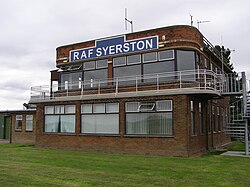RAF Syerston
| RAF Syerston | |||||||||||||
|---|---|---|---|---|---|---|---|---|---|---|---|---|---|
| Near Newark-on-Trent, Nottinghamshire in England | |||||||||||||

Tower in 2006
|
|||||||||||||
|
Shown within Nottinghamshire
|
|||||||||||||
| Coordinates | 53°01′24″N 000°54′42″W / 53.02333°N 0.91167°WCoordinates: 53°01′24″N 000°54′42″W / 53.02333°N 0.91167°W | ||||||||||||
| Type | Royal Air Force station | ||||||||||||
| Site information | |||||||||||||
| Owner | Ministry of Defence | ||||||||||||
| Operator | Royal Air Force | ||||||||||||
| Site history | |||||||||||||
| Built | 1939/40 | ||||||||||||
| In use | 1940-Present | ||||||||||||
| Airfield information | |||||||||||||
| Identifiers | ICAO: EGXY | ||||||||||||
| Elevation | 69 metres (226 ft) AMSL | ||||||||||||
|
|||||||||||||
RAF Syerston (ICAO: EGXY) is a Royal Air Force station in the parish of Flintham, near Newark, Nottinghamshire. It was used as a bomber base during the Second World War.
Syerston was built as part of the bomber expansion in the late 1930s, but did not open until 1 December 1940. The first aircraft were Vickers Wellingtons crewed by Polish flyers. In July 1941 they were replaced by members of the RCAF flying Handley-Page Hampdens. From December 1941 until 5 May 1942, the base was closed whilst a concrete runway was built with two T2 hangars. When it re-opened, it became part of No. 5 Group. In 1942 several squadrons of Avro Lancaster aircraft arrived. In 1943 Bill Reid of 61 Squadron won a Victoria Cross on a mission flown from Syerston.
On 17 November 1943 the operational squadrons departed, and the station was used for bomber crew training, led by Captain Robert White. It became known as the Lancaster Finishing School in January 1944. From November 1943 to July 1944 there was also a Bombing and Gunnery Defence Training Flight in attendance with several Wellingtons, Spitfires, Hurricanes, plus a few Martinet tug aircraft, all employed in brushing up the skills of air gunners on air-to-air exercises. The LFS left on 1 April 1945, with No. 49 Squadron arriving from RAF Fulbeck later in the month who only had one operation before leaving to RAF Mepal in September.
On 25 October 1945, the base became part of Transport Command with a Heavy Conversion Unit arriving from RAF Leicester East, which stayed until 5 January 1948 when it moved to RAF Dishforth. Syerston was taken over by Flying Training Command on 1 February 1948 when No.22 Flying School arrived from RAF Ouston which trained pilots for the Fleet Air Arm (FAA). Other nearby airfields used for flying circuits were RAF Newton, RAF Wymeswold and Tollerton airfield (now Nottingham Airport). The training school became No. 2 Flying Training School RAF in 1955. In November 1953, Percival Provosts began being used, being replaced by the (Hunting Percival) Jet Provost in 1959. The flying training school was disbanded on 16 January 1970 when the need for pilots had diminished, and the station lay vacant.
...
Wikipedia

